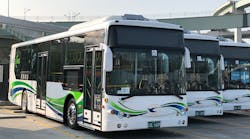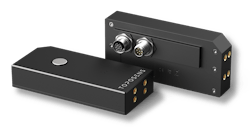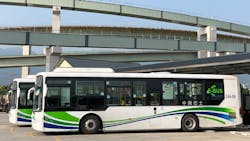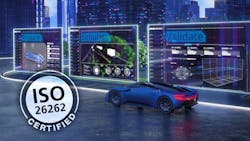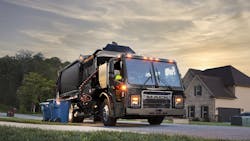This Week in Power & Motion: Danfoss Editron Electric Drivetrain Aids Electrification of Buses in Taiwan
There is much going on in the world of fluid power and motion control, from technology introductions and industry advancements to new trends and industry leaders. To keep our readers as informed as possible, the Power & Motion team has collected some of the latest industry news.
Among this week's bigger announcements was that of Bosch Rexroth signing a deal to acquire HydraForce. The companies said their technologies and businesses complement one another, and the merger will enable a further market expansion.
This past week also brought news of powertrain manufacturer Cummins Inc. naming a new CEO, Jennifer Rumsey, who will be the first woman in the position. Rumsey has spent much of her career at Cummins, and helped lead efforts to diversify its portfolio to include battery and fuel cell power systems.
In the electrification space, big announcements were recently made by the U.S. Postal Service (USPS) and Ford. USPS announced July 20 an adjustment to its planned upgrade of its fleet. It now intends to have at least 50% of its Next Generation Delivery Vehicles (NGDVs) be electric, up from the 10% it originally said the new fleet would contain. Meanwhile, Ford Motor Co. has announced it will expand battery capacity and sourcing to enable the company to continue growing production for electric vehicles.
READ MORE on the Ford news from our colleagues at EnergyTech.
Keep an eye out for a new edition each week to ensure you stay up to date on what's happening in the world of fluid power and motion control.
DOE Announces Funding for Clean Vehicle Technologies
The U.S. Dept. of Energy (DOE) has created a $96 million funding opportunity to aid development of lower emissions transportation solutions. Funding will be focused on:
- expanding electric vehicle charging accessibility,
- designing cleaner off-road vehicles through electrification and alternative fuels,
- development of electric drive components and materials to maximize EV efficiency and affordability.
The funding supports President Biden's target of the U.S. becoming a net-zero economy by 2050. DOE noted in its press release announcing the new funding that applicants must show how proposed projects will benefit traditionally disadvantaged communities that lack access to clean energy sources as part of President Biden's Justice40 Initiative.
WATCH: 3 Drivers of Off-Highway Electrification
Toposens Introduces Collision Avoidance Sensor for AGVs and Robots
Toposens, a high-tech startup based in Munich, is introducing its first commercial sensor for mobile robot collision avoidance systems. The ECHO ONE sensor utilizes Toposens' 3D ultrasonic echolocation technology to improve visibility of the environment around mobile robots. It can be paired with the Toposens processing unit which features sophisticated filters for 3D collision avoidance to create a complete system solution.
As Toposens explained in its press release announcing the launch of the sensor, it sends obtained data collected via echo reflections perceived by three microphones in a 3D point cloud format to the Toposens PROCESSING UNIT which is equipped with an easy-to-configure advanced 3D collision avoidance software. Based on this data, the processing unit gives commands to the mobile robot—slow down, stop or keep moving.
The company believes the ECHO ONE improves upon existing sensor technologies and cameras currently utilized which either deliver 2D data or have limitations on what they can perceive.
"Being able to detect multiple difficult-to-detect obstacles reliably and in real-time, regardless of environmental conditions, enables us to provide next-level robotic safety for our customers. Our technology addresses the shortcomings of optical sensors, such as LiDARs, which can fail to detect floor-based objects like forklift forks on the floor, in unfavorable lighting conditions or transparent or mirrored object surfaces. Receiving data output in 3D, meaning in x, y, and z coordinates, guarantees the most reliable level of 3D collision avoidance," said Tobias Bahnemann, CEO and co-founder of Toposens, in the company's press release.
Danfoss Editron Powering Electric Buses in Taiwan
Danfoss Power Solutions' Editron division has provided fully electric drivetrains to Taiwan's national bus operator Chung-Shin Bus Group which is developing its own electric buses to aid the country's emissions reduction efforts. Taiwan has set a goal for itself to become a net-zero country by 2050; to achieve this it has established several transportation related goals including the transition of its entire fleet of 16,000 buses to electric power by 2030.
The Danfoss Editron PMI318B electric drivetrain used in the buses is comprised of an electric motor, inverter and six-speed transmission. It features a compact and lightweight design for ease of installation and mobility. Per Danfoss Editron, the electric drivetrain provides a 30% efficiency increase and reduced operational costs compared to diesel-powered alternatives.
In Danfoss Editron's press release announcing the project in Taiwan, Christopher Natter, vice president of OEM sales for Danfoss Power Solutions, said the high torque performance, wide operation range and integrated gearbox of the company's electric drivetrain is well suited for use in the buses.
Chung-Shin Bus Group is planning to produce 150 fully electric buses equipped with the Danfoss Editron technology by the end of 2022. The buses will be deployed in Taipe and new Taipei City. Another 100 electric buses are planned to go into service in 2023.
dSPACE Autonomous Driving Software Receives ISO Certification
dSPACE's SIMPHERA software, a cloud-based simulation and validation solution for autonomous driving functions, has received ISO 26262 certification from testing and certification organization TÜV Süd. The certification helps to ensure the safety of systems under development and speed up the development process for design teams.
Because the software is certified to ISO 26262, developers can be assured the systems they are designing in the software will meet this standard. They can instead focus on ensuring the functional safety of their designs, stated dSPACE in its press release announcing the certification.
dSPACE also plans to work with TÜV Süd to develop a new procedure that will enable continuous certification of software and its subsequent updates. This will help to keep the design process safe yet productive.
"We want our customers to be able to focus on their core competencies when developing applications for autonomous driving functions, and to use dSPACE's tools with the certainty that the functions developed with them will meet the highest industry standards in terms of functional safety," said Tino Schulze, executive vice president, Automated Driving & Software Solutions at dSPACE, in the company's press release.
City of Mobile Orders Mack LR Electric
Mack Trucks has announced the receipt of an order for its Mack LR Electric Class 8 refuse vehicle from the City of Mobile, Ala. The city has ordered the battery-electric refuse truck to help meet sustainability goals.
The truck is powered by four NMC (Nickel Manganese Cobalt Oxide) lithium-ion batteries as well as two electric motors capable of producing 448 continuous horsepower and 4,051 lb.-ft. of peak torque output from zero RPM. Regenerative braking is utilized as well to capture and reuse energy that would otherwise be wasted to provide additional power to the truck. These features enable the truck to operate efficiently without producing carbon emissions, which benefits the City of Mobile's sustainability goals.
News of orders like this demonstrate the continued adoption of electric vehicles (EVs) in various applications. In refuse, electric powered vehicles can be particularly beneficial as they are typically operating in residential areas where the lack of emissions and reduced noise common with EVs is desired.
The City of Mobile plans to use its new Mack LR Electric in residential areas and utilize a portable charging station so it can test use of the vehicle in various locations around the city. "As the first electric vehicle in our public services fleet, we wanted something that could keep up with our existing trucks and our team members could quickly learn to operate," said Mobile Mayor Sandy Stimpson in Mack Trucks' press release announcing the order. "The LR Electric provides the kind of comfort and usability we wanted for our staff, as well as the reliability we’ve come to expect from a Mack truck."
WATCH AND LEARN: Hear more from Mack Trucks and other OEMs about the development of electric vehicles in our Engineering Academy session "An OEM's Perspective on Going Electric."
